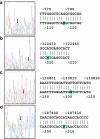Mutations in mammalian tolloid-like 1 gene detected in adult patients with ASD
- PMID: 18830233
- PMCID: PMC2986167
- DOI: 10.1038/ejhg.2008.175
Mutations in mammalian tolloid-like 1 gene detected in adult patients with ASD
Abstract
Atrial septal defect (ASD) is an incomplete septation of atria in human heart causing circulatory problems. Its frequency is estimated at one per 10 000. Actions of numerous genes have been linked to heart development. However, no single gene defect causing ASD has yet been identified. Incomplete heart septation similar to ASD was reported in transgenic mice with both inactive alleles of gene encoding mammalian zinc metalloprotease a mammalian tolloid-like 1 (tll1). Here, we have screened 19 ASD patients and 15 healthy age-matched individuals for mutations in TLL1 gene. All 22 exons were analyzed exon by exon for heteroduplex formation. Subsequently, DNA fragments forming heteroduplexes were sequenced. In four nonrelated patients, three missense mutations in coding sequence, and one single base change in the 5'UTR have been detected. Two mutations (Met182Leu, and Ala238Val) were detected in ASD patients with the same clinical phenotype. As the second mutation locates immediately upstream of the catalytic zinc-binding signature, it might change the enzyme substrate specificity. The third change, Leu627Val in the CUB3 domain, has been found in an ASD patient with interatrial septum aneurysm in addition to ASD. The CUB3 domain is important for substrate-specific recognition. In the remaining 15 patients as well as in 15 reference samples numerous base substitutions, deletions, and insertions have been detected, but no mutations changing the coding sequence have been found. Lack of mutations in relation to ASD of these patients could possibly be because of genetic heterogeneity of the syndrome.
Figures


References
-
- Kahler RL, Braunwald E, Plauth WH, Jr, Morrow AG. Familial congenital heart disease: familial occurrence of atrial septal defect with A-V conduction abnormalities, supravalvular aortic and pulmonic stenosis, and ventricular septal defect. Am J Med. 1966;40:384–399.
-
- Boughman JA, Berg KA, Astemborski JA, et al. Familial risks of congenital heart defect assessed in a population based epidemiologic study. Am J Med Genet. 1987;26:839–849. - PubMed
-
- Van Mierop LHS.Embryology of the atrioventricular canal region and pathogenesis of endocardial cushion defectsin Feldt RH, McGoon DC, Ongley PA, Rastelli GC, Titus JL, Van Mierop LHS (eds):Atrioventricular Canal Defects Philadelphia, PA: WB Saunders; 19761–12.
-
- Hoffman JI. Congenital heart disease: incidence and inheritance. Pediatr Clin North Am. 1990;37:25–43. - PubMed
-
- Fyler DC.Atrial septal defect secundumin Fyler DC (ed):Nadas Pediatric Cardiology Boston, MA: Mosby Year Book Inc.1992513–524.
Publication types
MeSH terms
Substances
LinkOut - more resources
Full Text Sources
Molecular Biology Databases
Research Materials

